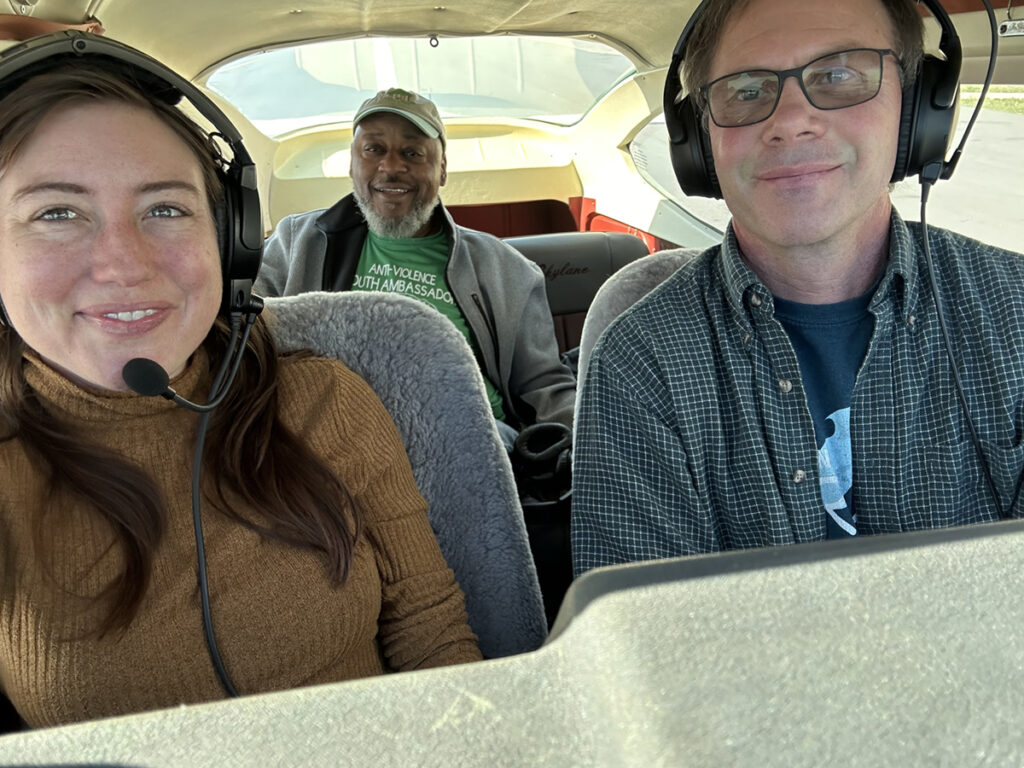News
Flight an education on coal ash cleanup
CAFOs, Environmental, Neuse River Watershed, Sound Rivers, Water Quality
Posted on March 14th, 2024
The Neuse River runs between the HF Lee coal ash basin and Quaker Neck Lake.
Neuse Riverkeeper Samantha Krop invited a special guest to have a look at past and potential eastern North Carolina polluters from above.
Bobby Jones, founder of the Down East Coal Ash Environmental and Social Justice Coalition, joined Sam and SouthWings volunteer pilot Rolf Wallin for a Tuesday morning flight out of Goldsboro.
“It was wonderful to be able to go up with Bobby,” Sam said. “He is one of my personal heroes, an amazing community organizer out of the Goldsboro area. He’s done a ton of work, including CAFOs, and is one of the huge movers and shakers in getting Duke Energy to clean up the coal ash at the H. F. Lee plant.”

Their flight took them over several CAFOs (concentrated animal feeding operations, or industrial hog facilities) along the Neuse River and its tributaries, as well as over the HF Lee plant. Sam said, even with the constant interruption of air traffic chatter, she learned a lot during the flight.
“Bobby told me his concerns about Duke Energy’s removal of the coal ash from the banks of the Neuse River,” she said.
Duke Energy pleaded guilty in 2015 to federal environmental crimes after an investigation found the company allowed coal ash dumps at five power plants to leak toxic waste into water supplies. The company agreed to pay $102 million in fines and restitution. During Hurricane Matthew the following year, an inactive coal ash basin was overrun at the HF Lee plant, releasing an unknown amount of coal waste into the Neuse River. In January of 2020, Sound Rivers with numerous environmental partners, represented by the Southern Environmental Law Center, reached a settlement agreement with Duke Energy to clean up the coal ash from the HF Lee facility and five other facilities in the state. The settlement resulted in the largest coal ash cleanup in America at that time. While the ash from the banks of the Neuse River is being recycled into concrete — limiting the problem with moving it to another area of the state and into a landfill that could have further caused contamination — that takes time, and the cleanup will not be completed for at least a decade.
“The coal ash basin is huge — shockingly huge,” Sam said. “The scope of the problem is really made apparent from the sky. You see these ‘tiny’ tractors pushing around ‘tiny’ mounds of coal ash on this moonscape. There’s only so much that they can turn into concrete in a year, so it’s going to be on the banks of the Neuse for a long time.”
The flight wasn’t all gloomy, though. Mr. Jones greatly enjoyed his first time on a little plane and very much appreciated being able to see from above the places he’s been working on for so long, Sam said.
Related News

DEQ issues notice of violation to Rocky Mount
July 17th 2025

Specialist tracking pollution impacts on urban waterway
July 17th 2025

Riverkeeper tracks post-Chantal pollution on the Eno
July 17th 2025

‘Power Bill Reduction Act’ will raise costs, climate-change risk
July 17th 2025

Riverkeepers track down purposeful pollution
July 17th 2025

Riverkeeper, program assistant show up for Pride on the Tar
July 17th 2025

Specialist investigates lake connection to mysterious skin rash
July 10th 2025

Riverkeeper: Central NC flooding part of a much larger issue
July 10th 2025

